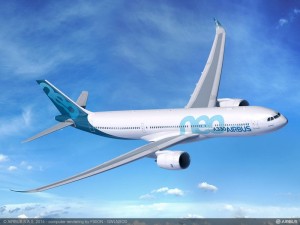Aerospace giant Airbus this week deployed world-leading wing technology developed in Bristol to launch a new, more fuel-efficient version of its dated A330 long-range aircraft.
Engineers based at its Filton plant have already played key roles in designing innovative ‘winglets’ for Airbus’s all-new A350 mid-range jetliner and the highly-successful updated version of its A320 short-haul plane.
Now the pioneering designs are to be incorporated on new versions of the wide-body A330 announced today to the world’s aerospace industry at the Farnborough Airshow. 
The A330-800neo (new engine option) and A330-900neo was launched with much fanfare at the Farnborough Airshow. It will allow European-owned Airbus to compete against arch-rival Boeing’s 787 Dreamliner in the all-important long-haul market segment.
Pictured: A computer-generated image of a new A330neo showing the Bristol-designed winglets
Airbus immediately followed the launch announcement by revealing that it had signed a Memorandum of Understanding for 25 of the updated aircraft with long-standing customer Air Lease Corporation (ALC), the Los Angeles-based aircraft leasing company. ALC simultaneously announced a firm order for 60 A321neo aircraft.
Airbus president Fabrice Brégier said: “When a leading lessor, ALC, is the first to sign up for a new aircraft, it’s a loud and clear signal that you’ve got it right.
“This significant order is a strong endorsement of both our A330neo and A320neo, confirming they fully meet the needs of the world’s most demanding airlines.
“The continuing success of the A320neo, paves the way for the A330neo and proves that our incremental innovation strategy to deliver reliable, innovative and efficient products at the right time, is what the market wants.”
ALC chairman and chief executive officer Steven F. Udvar-Házy added: “We see a significant market opportunity for the A330neo and we’re pleased that the first order bears ALC’s name. The A321neo credentials, such as its lower fuel-burn, high reliability and wider, more comfortable cabin, also fit well in our product portfolio of innovative, profitable aircraft.”
The A330 made its first commercial flight in 1994 and although nearly 1,100 remain in operation Airbus has fewer than 250 on its order books – around two years’ worth at current production rates.
At the same time, US giant Boeing’s Dreamliner, which entered service nearly three years ago, is picking up valuable orders from long-haul airlines.
Airbus said adding the winglets – also known as sharklets – to the A330neo’s wings and using the latest Rolls-Royce Trent 7000 engines will reduce the aircraft’s fuel consumption by 14% making it the most cost-efficient, medium-range widebody aircraft on the market.
The first deliveries of the new A330 are scheduled to start in the ffinal quarter of 2017. Airbus believes that it can sell 1,000 of the A330neos.
The A330-900neo will have up to 10 additional seats (from 300 to 310), while the A330-800neo will seat up to six additional passengers (from 246 to 252), Airbus said.
The A330neo was announced on the first day of the biennial Farnborough Airshow – which alternates on a yearly basis with a similar global industry gathering in Paris. Day one is traditionally taken up by the rivalry between Airbus and Boeing.
The US group dismissed the updated A330 even before it was officially launched with chief executive James McNerney quoted in the FT as saying: “Our experts tell us that [the A33neo] will not get close to our 787 versions in terms of fuel efficiency”.
Airbus plans to sell the A330neo cheaper than the Dreamliner 787, mainly because it will be built from traditional aluminium rather than advanced, lightweight composite materals. However, the winglets will be constructed from composite material in the same way as those used on the A350.
Airbus employs around 4,000 people at Filton working primarily on wing design, landing gear and fuel systems. Most wings sections designed by Airbus are now made by GKN Aerospace at its Filton base – which it bought from Airbus in 2008. GKN Aerospace also has a new plant at Severnside making composite wing sections for the A350.
Meanwhile, British Airways owner International Airlines Group (IAG) converted options it had on 20 A320neo aircraft into firm orders. The aircraft are intended to replace 21 short-haul British Airways’ aircraft.
BA already operates 120 Airbus single-aisle aircraft in the A320 family ranging from the smallest A318 to the largest A321.
Airbus chief salesman John Leahy said: “IAG’s’ selection of the A320neo family for its single-aisle fleet is a significant win for Airbus.
“It is with great pride that one of our biggest and most influential customers recognise the superior operating economics and passenger appeal of the A320neo family.
“This order strengthens the A320neo Family as the single aisle aircraft of choice for the world’s leading airlines.”





























